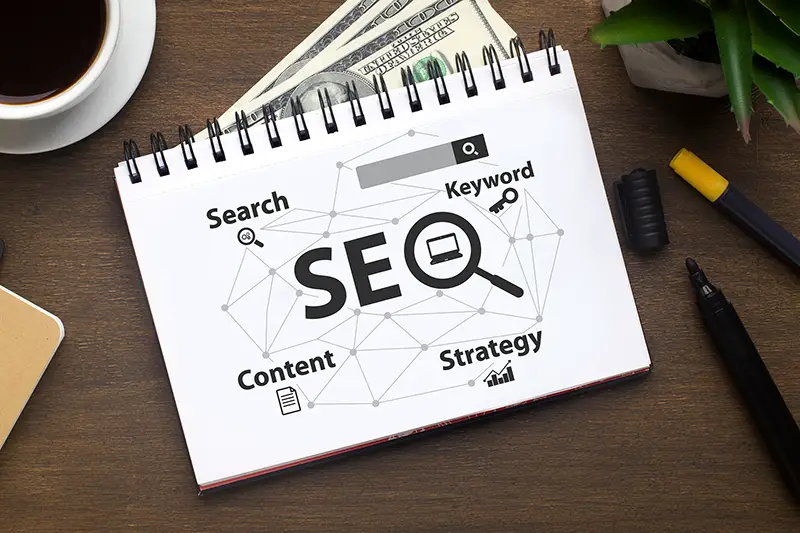
Last year was quite a year for Google’s search algorithm. SEO professionals did feel a bit bushwhacked by the tech giant’s core algorithm update in November last year. Moreover, Google’s search results were almost 80% more volatile last year in comparison to 2020.
Hence, these headlines highlight Google’s rising focus on making its search algorithm more effective. Moreover, its ongoing mission is to deliver the best and most relevant search results to billions of users it serves.
A lot of changes have taken place in the arena of organic searches. As a result, it is now a good time for marketing teams and professionals to take a much more holistic view of SEO efforts and opportunities for improvement, especially in terms of content marketing and website performance.
SEO is still frequently demoted to UX teams and web design. This might make the idea of completely integrating SEO into existing digital marketing work an overwhelming task.
But with the first-page of Google search results receiving 92 percent of all organic search traffic, the benefits a company has in investing in SEO as part of its efforts in content marketing can never be taken for granted nor understated.
Let us now start with the basics.
Search Engine Optimization (SEO) is the practice of raising the quality and quantity of website visits through organic search results served to users by search engines, notably Google.
Alternative search engines like Bing and Start Page continue to draw new users, and Google still handles more than 90% of all search queries globally. Moreover, a vast majority of the audiences are present on Google. For example, approximately 90% of B2B researchers use Google to research potential business acquisitions and purchases.
Many people and professionals think that SEO isn’t as important to digital marketing as Pay-Per-Click (PPC) ads because a lot of companies run them. Other advertising also may have diminished SEO’s importance because they try to ensure a steady stream of visitors to their website or landing pages.
PPC, meanwhile, is undoubtedly an effective tactic in terms of paid promotion and promoting content strategically via search engines. Approximately 80% of Google users often click on organic search results (non-paid ones).
This indicates that SEO matters a lot regardless of any company’s paid media spending percentage.
Those who wish to have some help in obtaining a purchase-in for an SEO strategy or more budget for SEO tasks must know that 57% of B2B marketers agree that SEO generates more leads than any other marketing initiative.
Moreover, numerous firms and research bodies indicate that B2B companies generate twice as much revenue from organic search than any other marketing channel. Therefore, SEO should be part of digital marketing efforts and be close to each digital marketer as possible.
SEO is more than about making Google happy. In the early days of the internet, optimizing content for SEO was based on stacking content with keywords (keyword stuffing). This one was carried out strategically so that when Google’s algorithm crawled the website, it could understand the topics and rank content accordingly.
At that time, the content’s quality did not matter much.
Now Google leverages more advanced artificial intelligence and natural language processing technologies. This helps in improving search engine results. Moreover, they help Google’s algorithm better understand a website’s content along with its quality. This is the reason its search algorithm has become smarter than ever.
Considering Google’s focus on factors like quality of content, mobile optimization, and top-notch user experience, the website’s overall content quality and experience are quite some factors today compared to previous tactics of keyword stuffing on a particular web page.
Here are some key and noteworthy tactics and best practices content marketers can utilize to help jump-start their efforts to optimize content for SEO and improve organic search visibility and results this year too:
In SEO, low volume keywords were often taken for granted. They never garnered the millions of searches needed each month. Yet they are critical for the bottom line.
Low volume keyword searches didn’t bring in many waves of new website traffic; they can yet deliver more qualified traffic to the website. This is often seen in effective marketing segmentation, where more segmented and specific keywords relevant to the business, customers and the website are targeted.
What does it result in? More on-site engagement and conversions. All this is done thanks to worthwhile keyword research.
This might be tricky, but it is needed. When writing about something, content marketers must ensure that they are writing to a middle schooler. As strange as it may seem, simple writing helps website visitors understand content quickly and much more easily, regardless of the industry.
It ensures user-friendliness of content and makes translation easier. This benefits local and international clients where English is not the first language. It even helps remove jargon and averts usage of unnecessary acronyms. Clarity is hence kindness.
This might include paragraphs of single sentences as they can help emphasize key insights and make some white space. Thus this aids in readers comprehending the content.
Bullet points, graphs, numbered lists, quote boxes, and other pattern interrupts help in ease of scanning and reading.
MIT’s Sloan Review excels at summarizing why a particular piece of content would matter at the start of each article. As an additional bonus, thoughtful design elements and entails such as estimated reading time can help set readers’ expectations and make synopses easy to find and easy to understand.
It matters because a helpful summary (hook) helps orient the reader, which helps raise the dwell time. In addition, it is a metric Google uses to see if a search result was valuable to the user or not.
Almost 80 percent of readers usually do not make it past the headline. This means a vague or boring headline which can negatively impact dwell time. It can even stop quality content from getting worthwhile engagement.
Content Marketers should pay attention to headline research studies in understanding what works well when it comes to content titles. In addition, lists and how to do so are worthwhile options.
A subheading is a mini-headline within the content. It plays a perfect role in catching a reader’s attention. Many content teams use questions and statements as subheadings to improve readability.
No need to put keywords in subheadings. They haven’t been a ranking factor since the early 2000s. But they are helpful in helping Google’s crawlers understand the content.
They are short page descriptions appearing under the content title in search results. They aren’t official ranking factors for search engines, but they can influence whether or not a page was clicked on. It is like an ad copy and can affect the rankings too. Hence the Meta description should be clear, concise, and of course, helpful.
It makes website images accessible for those who cannot see them. Alt Image Text also helps Google crawlers understand the image. It ultimately helps the engine understand the content on an improved footing. Google uses the image URL, file name and alt text to determine the image’s content itself.
It should be noted that stuffing an image alt text with keywords or marketing copy will not give it any SEO points. Instead, providing accurate image descriptions helps the content become more trustworthy and accessible. The former is a key part of Google’s Expertise, Authoritativeness and Trustworthiness (E-A-T) guidelines for content.
The average length of content from the top positioned Google article contains 2416 words on average. Content Marketers should try looking at the top-ranking content for a given keyword or search query. Then they should try doubling (or tripling or more) the word count through the provision of a more in-depth exploration of a topic.
Outdated content, for instance, can be updated with fresh keyword research, stats and good graphics. As a result, organic traffic can grow up to 106% after updating and republishing old blog posts.
These tips may sound easy, but they are often taken for granted. These tips are helpful and can help improve standards and optimization of content for both SEO and digital marketing.
You may also like: SEO for Small Business: Reasons Why Your Company Should Consider it
Image source: Shutterstock.com

Generating leads is a crucial...

Welcome to the Future of...

It is evident that social...